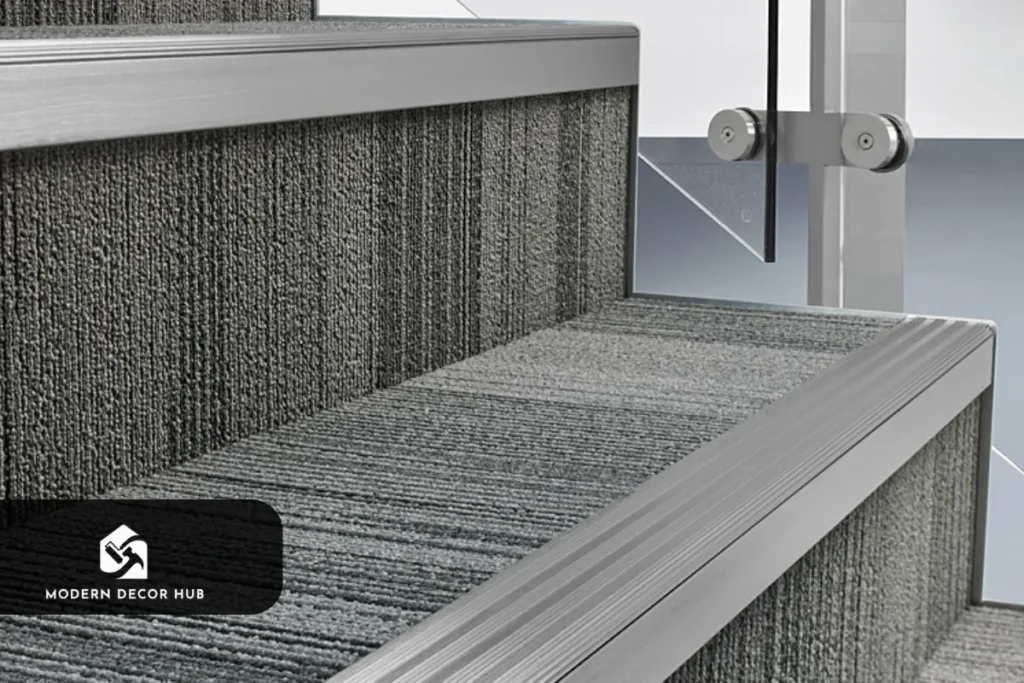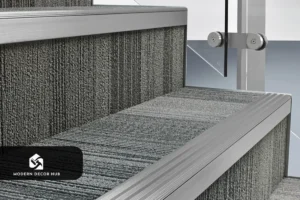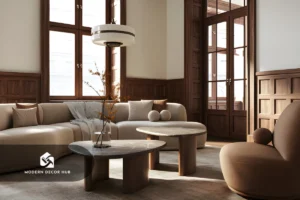Introduction to Stair Nosing
What is Stair Nosing?
Stair Nosing is the front edge or finishing strip installed on each stair tread. It is a small yet essential component that enhances both the appearance & safety of your stairs. The nosing of the stair protects stair edges from wear, improves grip, and provides a clean, professional finish. Whether your stairs are made of wood, concrete, vinyl, or metal, adding stair nosings significantly extends their lifespan.
In simple terms, stair nosing is like a protective shield for your stairs. It prevents chipping, reduces slips, and can even improve the visibility of each step. This is especially important in high-traffic areas, commercial spaces, or homes with children & elderly people.
Why Stair Nosing Matters
- Safety First: Anti-slip stair nosing prevents falls & accidents.
- Durability: Protects the stair edge from everyday wear & tear.
- Aesthetic Appeal: Adds a finished, polished look to your staircase.
- Cost-Effective: Prevents costly stair repairs by reinforcing edges.
Even the smallest bump or scuff can damage unprotected stairs. With stair nosings, you not only improve functionality but also elevate your stair design.
Where Stair Nosing is Used
Stair nosing can be installed on almost any type of stair:
- Wooden Stairs: To prevent splintering & complement hardwood finishes.
- Concrete Stairs: Often with anti-slip inserts for outdoor or industrial use.
- Vinyl or LVT Stairs: To blend seamlessly with the flooring while enhancing safety.
- Metal Stairs: Adds grip & protects against dents or scratches.
Common Misconceptions
Many people think stair nosing is purely decorative, but its main function is safety & protection. Skipping this small addition can lead to:
- Faster wear on stair edges
- Increased risk of slipping & accidents
- Higher maintenance or replacement costs
Key Takeaway: Installing stair nosing is a small investment that delivers big benefits in safety, durability, & style.
Types of Stair Nosing
Understanding the Different Types of Stair Nosing
Stair Nosing comes in a variety of materials & designs to suit different stair types, locations, and safety requirements. Choosing the right stair nosing ensures both durability & style. Whether you need anti-slip stair nosing for safety or elegant wood stair nosing for aesthetics, there’s an option for every staircase.
Below is a detailed look at the most popular stair nosing types.
1. Vinyl Stair Nosing
Vinyl stair nosing is one of the most versatile & cost-effective options. It is highly durable, resistant to moisture, and available in a wide range of colors & finishes.
Benefits of Vinyl Stair Nosing:
- Low maintenance & easy to clean
- Provides anti-slip surfaces
- Ideal for both residential & commercial spaces
- Affordable & quick to install
Where to Use: Schools, offices, hospitals, or any high-traffic area where durability & safety are priorities.
2. Metal Stair Nosing
Metal stair nosing is extremely strong, making it perfect for heavy-use stairs. Materials include aluminum, steel, or brass, and they often come with anti-slip profiles.
Advantages:
- Long-lasting & resistant to impact
- Can be installed indoors & outdoors
- Offers modern & sleek appearance
- Available in black metal stair nosing or black aluminum stair nosing for style
Popular Uses: Commercial buildings, industrial areas, or staircases with high foot traffic.
3. Wood Stair Nosing
For a classic, natural look, wood stair nosing is the top choice. Common woods include oak, maple, or cherry, which can be stained or finished to match the stair treads.
Benefits:
- Blends seamlessly with wood stairs
- Durable & long-lasting when properly finished
- Can feature rounded (bullnose stair nosing) or square profiles (square stair nosing)
Where to Use: Residential homes with hardwood stairs, or decorative staircases where aesthetics matter.
4. Tile & Concrete Stair Nosing
Tile stair nosing adds a polished, waterproof edge to tiled stairs, while concrete stair nosing is perfect for outdoor steps or industrial environments.
Key Points:
- Concrete nosing increases durability of stair nosing for concrete steps
- Tile nosing complements bathroom or kitchen floors
- Can include anti-slip inserts for safety
Where to Use: Outdoor stairs, patios, or tiled interiors requiring edge protection.
5. LVT Stair Nosing
Luxury Vinyl Tile (LVT) stair nosing is designed to match vinyl plank flooring seamlessly. It offers a clean, modern look while ensuring durability & slip resistance.
Benefits:
- Matches flooring perfectly
- Easy to maintain
- Offers anti-slip protection
Where to Use: Modern homes, apartments, or commercial spaces with LVT floors.
6. Bullnose vs. Square Stair Nosing
Bullnose stair nosing has a rounded edge, giving a soft, classic finish. Square stair nosing has a straight edge for a contemporary, minimalist look. Both types can be found in wood, metal, or vinyl.
Key Considerations:
- Bullnose: Best for traditional or elegant stair designs
- Square: Works well in modern or industrial interiors
Materials & Profiles of Stair Nosing
Introduction to Stair Nosing Materials
Choosing the right stair nosing material is critical for both safety & durability. The material of the stair nosing affects its lifespan, appearance, and suitability for different stair types. From wood stair nosing to metal stair edge nosing, each material offers unique benefits.
Understanding stair nosing profiles is also important. The profile refers to the shape of the nosing edge, such as bullnose, square, or anti-slip inserts. Selecting the right profile improves both aesthetics & safety.
1. Aluminum & Metal Stair Nosing
Aluminum Stair Nosing
Aluminum stair nosing is lightweight, corrosion-resistant, & ideal for high-traffic areas. It is often paired with anti-slip strips for enhanced safety. Aluminum can be anodized, painted, or powder-coated to match the design of your stairs.
Benefits:
- Extremely durable & long-lasting
- Resistant to weather & corrosion
- Available in black aluminum stair nosing or other finishes
- Suitable for indoor & outdoor use
Steel & Brass Stair Nosing
Steel & brass nosings offer strength & an elegant appearance. Steel is perfect for industrial spaces, while brass provides a decorative, high-end finish. Both can include stair nosing profiles for grip & slip resistance.
Use Cases: Commercial buildings, outdoor staircases, or industrial stairs where durability is essential.
2. Vinyl & LVT Stair Nosing
Vinyl Stair Nosing
Vinyl stair nosing is versatile, budget-friendly, and easy to maintain. It is ideal for both residential & commercial use. Vinyl can mimic the appearance of wood or stone while offering anti-slip functionality.
LVT (Luxury Vinyl Tile) Stair Nosing
LVT stair nosing matches luxury vinyl flooring seamlessly, giving a clean, cohesive look. LVT nosing is designed with anti-slip surfaces and often comes with hidden clips for a smooth, secure installation.
Key Advantages:
- Low maintenance & moisture-resistant
- Easy to install & replace
- Offers anti-slip protection without compromising style
3. Wood Stair Nosing
Oak & Hardwood Stair Nosing
Wood stair nosing is perfect for hardwood stairs, providing a natural, warm look. Popular choices include oak, maple, & cherry. Wood nosings can be finished with stains or paints to match your existing floor.
Profiles:
- Bullnose Stair Nosing: Rounded edge, elegant & classic
- Square Stair Nosing: Sharp, modern look for contemporary interiors
Benefits of Wood Nosing:
- Blends with wooden stairs seamlessly
- Can be sanded & refinished
- Adds timeless beauty while protecting stair edges
4. Concrete & Tile Stair Nosing
Concrete Stair Nosing
Used mainly for outdoor or industrial stairs, concrete stair nosing is extremely durable and can be reinforced with metal or rubber inserts for anti-slip protection.
Tile Stair Nosing
Tile nosing provides a smooth, water-resistant finish, ideal for kitchens, bathrooms, or tiled staircases. Tile nosings can include textured strips to improve traction.
Key Benefits:
- Long-lasting & highly durable
- Protects edges from chipping or wear
- Can be customized with anti-slip inserts for safety
5. Profiles of Stair Nosing
Stair nosing profiles determine both function & appearance. Common profiles include:
- Bullnose Stair Nosing: Rounded edge, ideal for wood stairs
- Square Stair Nosing: Straight edge, modern aesthetic
- Anti-Slip Stair Nosing: Textured or rubber inserts to prevent falls
- Metal Edge Nosing: Often perforated for extra grip
Choosing the right profile depends on stair material, traffic, & style preferences. Anti-slip profiles are recommended for public spaces or homes with children & elderly members.
Installing Stair Nosing
Introduction to Stair Nosing Installation
Installing stair nosing is a crucial step to protect stairs, improve safety, and give your staircase a polished finish. Whether you’re working with wood stair nosing, metal stair edge nosing, vinyl, or tile stair nosing, proper installation ensures longevity & functionality.
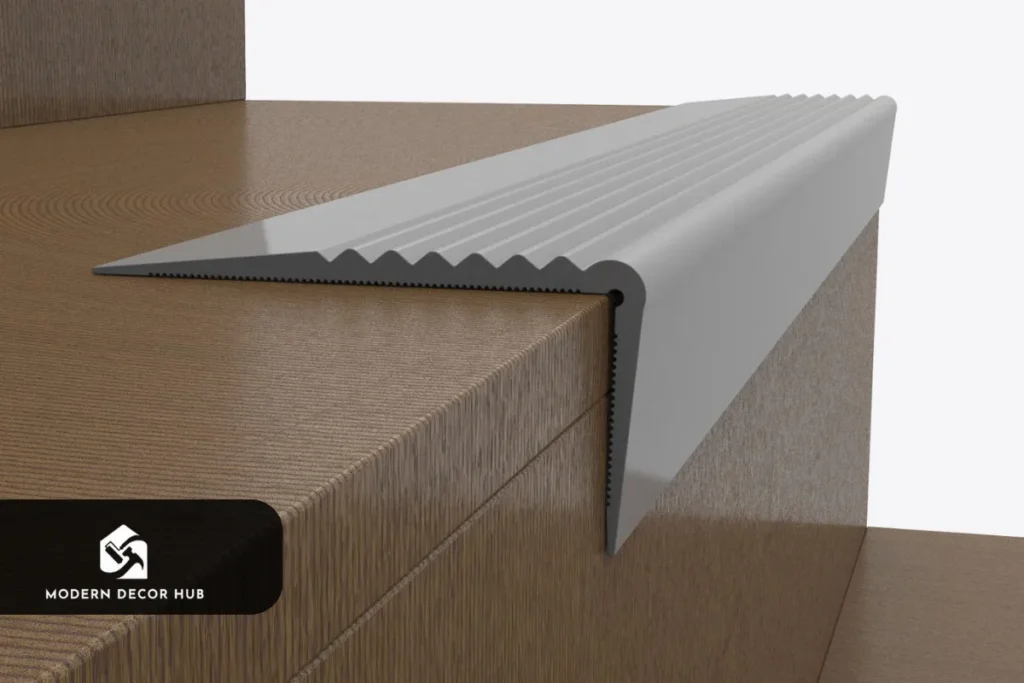
Stair nosing installation doesn’t have to be complicated. With careful planning, the right tools, and attention to detail, you can achieve professional results that enhance both safety & aesthetics.
Step 1: Measuring Your Stairs
Accurate Measurement is Key
Before installing stair nosing, measure the width & depth of each stair tread. Include any overhang to ensure the nosing fits snugly.
Tips for Measuring:
- Use a tape measure for precision
- Measure multiple stairs in case of slight variations
- Note the type of stair (wood, concrete, or vinyl) for material compatibility
Why It Matters:
Proper measurement prevents gaps, uneven edges, or loose stair nosing strips, which can reduce both safety & aesthetic appeal.
Step 2: Selecting the Right Material
Match Nosing to Stair Type
- Wood Stairs: Use wood stair nosing or compatible vinyl/metal strips
- Concrete Stairs: Use concrete-compatible or metal nosing with mechanical anchors
- Vinyl or LVT Stairs: LVT or vinyl nosing ensures a seamless look
Pro Tip: Always choose anti-slip stair nosing for high-traffic areas or spaces with children & elderly people.
Step 3: Preparing the Stair Surface
Clean & Level the Surface
- Remove dust, dirt, & debris
- Sand wood stairs to create a smooth surface
- Ensure concrete or tile surfaces are even & dry
Why Preparation is Crucial:
A clean, level surface ensures strong adhesion or secure fastening of stair nosing, preventing it from loosening over time.
Step 4: Installing Stair Nosing
Adhesive Installation
- Apply construction adhesive suitable for the material
- Press the stair nosing firmly into place
- Allow adhesive to cure as per manufacturer instructions
Screw or Clip Installation
- Drill pilot holes if required
- Use screws or hidden clips to secure metal stair nosing or heavy-duty vinyl nosing
- Check alignment and ensure no edges are raised
Tips:
- For concrete stairs, mechanical fasteners are recommended
- Always ensure nosing of the stair is flush with the tread surface to prevent tripping
Step 5: Finishing Touches
Ensure Safety & Aesthetics
- Wipe away excess adhesive
- Apply finishing trim if needed
- Test each step to confirm it is secure & stable
Pro Tip: Use contrasting colors or anti-slip strips to make stair edges more visible, reducing slip risks.
Common Installation Mistakes to Avoid
- Improper measurement, leading to uneven or loose nosing
- Ignoring anti-slip features in high-traffic areas
- Using the wrong adhesive or fasteners for the material
- Skipping surface preparation, causing weak adhesion
Key Takeaway: Proper installation of stair nosing ensures safety, longevity, & a professional look. Following these steps minimizes accidents & protects your stairs from wear.
Choosing the Right Stair Nosing
Why Choosing the Right Stair Nosing Matters
Selecting the right stair nosing is essential for both safety & style. A poor choice can reduce durability, increase maintenance, or even create a slipping hazard. The perfect stair nosing balances function, aesthetics, and long-term value.
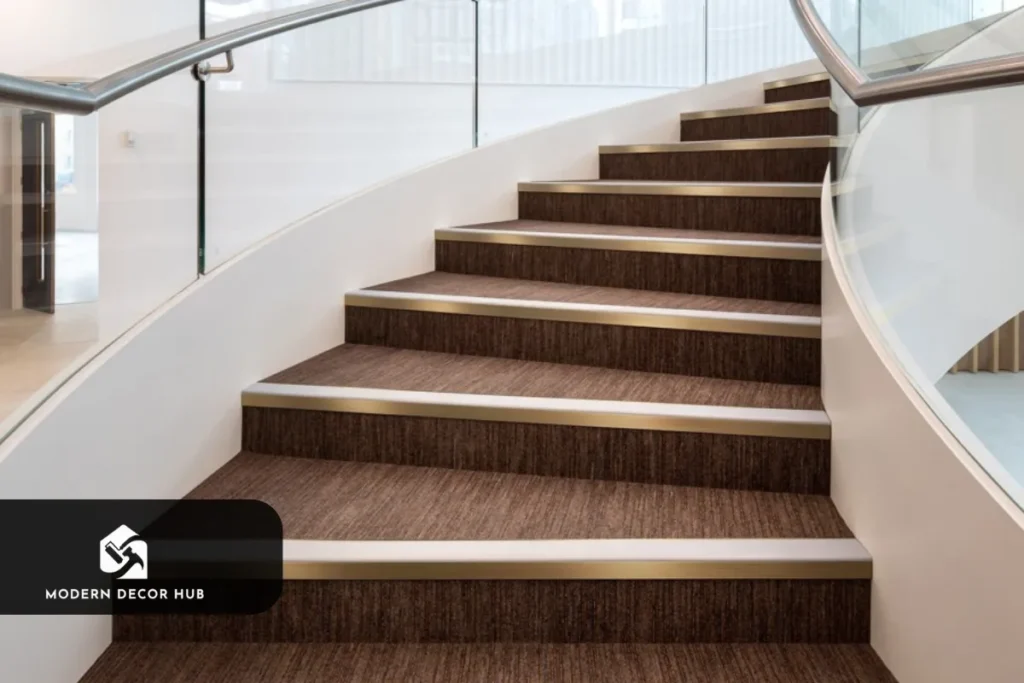
When choosing stair nosing, consider factors like material, traffic levels, slip resistance, and compatibility with your existing stairs. Whether it’s metal stair edge nosing for heavy traffic, wood stair nosing for elegance, or vinyl stair nosing for easy maintenance, the right choice makes a big difference.
1. Material Considerations
Wood Stair Nosing
- Ideal for hardwood stairs
- Offers a natural, warm look
- Can be finished to match stair color
- Available in bullnose stair nosing or square stair nosing profiles
Metal & Aluminum Stair Nosing
- Extremely durable, perfect for high-traffic areas
- Resistant to impact & corrosion
- Often features anti-slip profiles
- Available in black metal stair nosing or brushed finishes for modern interiors
Vinyl & LVT Stair Nosing
- Cost-effective & low maintenance
- Resistant to moisture & wear
- Matches vinyl or LVT floors seamlessly
- Includes anti-slip textures for safety
Tile & Concrete Stair Nosing
- Durable & water-resistant
- Suitable for outdoor or industrial stairs
- Can include textured inserts for anti-slip protection
Pro Tip: Always match the material to the stair type for maximum safety & durability.
2. Safety Features
Anti-Slip Stair Nosing
One of the most important factors is slip resistance. Anti-slip features can include:
- Textured metal strips
- Rubber inserts
- Raised or grooved surfaces
High-traffic areas, elderly residents, or outdoor stairs should always use anti-slip stair nosing to prevent accidents.
Visibility Enhancements
- Contrasting colors or reflective strips improve stair visibility
- Especially useful in low-light conditions or commercial spaces
3. Aesthetic & Style Considerations
Profiles Matter
- Bullnose Stair Nosing: Rounded edge, classic & elegant
- Square Stair Nosing: Straight edge, modern & minimalist
Color & Finish
- Match wood stair nosing to flooring
- Use black or metallic finishes for modern or industrial staircases
- Vinyl or LVT nosing can mimic natural materials for cohesive design
Aesthetic choices should complement your interior style while maintaining safety.
4. Maintenance & Durability
Wood Nosing
- Requires occasional polishing or refinishing
- Durable but prone to scratches without proper care
Metal Nosing
- Long-lasting & low maintenance
- Resistant to heavy foot traffic and wear
Vinyl & LVT Nosing
- Easy to clean & maintain
- Resists water, stains, and fading
Tip: Select materials based on expected traffic, environmental conditions, and willingness to perform maintenance.
5. Cost Considerations
- Vinyl nosing: Affordable, easy to replace
- Wood nosing: Moderate cost, elegant finish
- Metal/aluminum: Higher initial cost, but extremely durable
- Concrete/tile: Investment for outdoor & industrial stairs
Choosing the right stair nosing balances your budget with long-term durability and style.
Final Thought on Stair Nosing
Stair Nosing is more than just a decorative edge—it is an essential feature that combines safety, durability, & style. From wood stair nosing to metal stair edge nosing, and from vinyl to concrete stair nosing, each material offers unique benefits suited for different stair types and locations.
By choosing the right stair nosing type, material, & profile, you can:
- Prevent slips & accidents with anti-slip stair nosing
- Protect stairs from wear & damage
- Enhance the overall aesthetic of your home or commercial space
Proper installation ensures that the stair nosing strip fits securely, lasts longer, and performs its safety functions effectively. Matching the nosing with your stair material, traffic level, & design style guarantees both functionality & beauty.
Investing in quality stair nosing is a small step that offers big rewards: safer stairs, longer-lasting surfaces, and a polished look that elevates your entire staircase. Whether it’s a modern black metal stair nosing or a classic oak stair nosing, the right choice transforms your stairs into a safe & stylish feature.
Key Takeaway: Don’t overlook the importance of stair nosing—it’s a small addition with a huge impact on safety, durability, and design.
FAQs About Stair Nosing
1. What is stair nosing?
Stair nosing is the finishing edge added to the front of each stair tread. It protects stairs from wear, improves safety, & can enhance the appearance of your staircase.
2. What are the types of stair nosing?
Common types include vinyl stair nosing, metal stair nosing, wood stair nosing, tile stair nosing, concrete stair nosing, LVT stair nosing, bullnose stair nosing, and square stair nosing. Each type is designed for different stair materials & styles.
3. What is anti-slip stair nosing?
Anti-slip stair nosing has textured or rubber surfaces that prevent slipping. It is ideal for high-traffic areas, outdoor stairs, and homes with children or elderly members.
4. How do I install stair nosing?
Installation depends on the material:
- Wood & vinyl: Adhesive or screws
- Metal & aluminum: Screws or hidden clips
- Concrete: Mechanical anchors or specialized adhesive
Proper measurement, surface preparation, & alignment are essential for secure installation.
5. Can stair nosing be used on concrete steps?
Yes. Stair nosing for concrete steps protects edges, increases durability, and can include anti-slip inserts to improve safety. Concrete-compatible metal or vinyl nosing is recommended.
6. What is the best material for stair nosing?
It depends on your stairs & purpose:
- Wood stair nosing for hardwood aesthetics
- Metal/aluminum nosing for durability & heavy traffic
- Vinyl or LVT nosing for affordability & low maintenance
- Concrete/tile nosing for outdoor or wet areas
7. How do I choose the right stair nosing profile?
- Bullnose stair nosing: Rounded, elegant, classic look
- Square stair nosing: Straight, modern, minimalist style
- Anti-slip profiles: Textured or rubber inserts for safety
Choose based on design preference, stair material, & safety requirements.
8. Can stair nosing improve stair safety?
Yes. Installing stair nosing, especially with anti-slip features, reduces the risk of slips, improves step visibility, and reinforces stair edges, making stairs safer for everyone.

